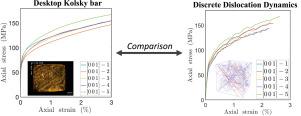Acta Materialia ( IF 9.4 ) Pub Date : 2023-03-13 , DOI: 10.1016/j.actamat.2023.118851 Sh. Akhondzadeh , Minju Kang , Ryan B. Sills , K.T. Ramesh , Wei Cai

|
A long standing challenge in computational materials science is to establish a quantitative connection between the macroscopic properties of plastic deformation with the microscopic mechanisms of dislocations in crystalline materials. Although the discrete dislocation dynamics (DDD) simulation method has been developed for several decades with the goal of addressing this challenge, a one-to-one comparison between the DDD predictions on single crystal stress–strain curves and experimental measurements under identical conditions has not been possible to date. Such a comparison is an essential step towards establishing a dislocation-physics based theory of plasticity and a multiscale framework of the plastic behaviors of crystalline materials. Here we provide direct comparisons between the stress–strain curves of Cu single crystals under high strain rate loading in the and directions obtained from miniaturized desktop Kolsky bar experiments and those from DDD simulations under identical loading conditions. With an appropriate set of parameters, DDD simulations can produce stress–strain curves that are in reasonable agreement with the experimental results. However, the dislocation mobility values needed to achieve this agreement are an order of magnitude lower than expected based on previous measurements and atomistic simulations. We hypothesize that this discrepancy could be caused by drag forces from jogs and point defects produced during the plastic deformation. Cross-slip of screw dislocations is also found to be necessary to capture the experimental stress–strain behavior, especially for the loading direction. This work provides an example of how direct comparisons between DDD simulations and experimental measurements can provide new insight into the fundamental mechanisms of plastic deformation.
中文翻译:

单晶铜高速变形实验与位错动力学模拟的直接比较
计算材料科学的一个长期挑战是在塑性变形的宏观特性与晶体材料位错的微观机制之间建立定量联系。尽管离散位错动力学 (DDD) 模拟方法已经开发了几十年以应对这一挑战,但单晶应力-应变曲线的 DDD 预测与相同条件下的实验测量之间的一对一比较还没有迄今为止可能。这种比较是朝着建立基于位错物理学的塑性理论和晶体材料塑性行为的多尺度框架迈出的重要一步。和从小型桌面 Kolsky 杆实验和相同负载条件下的 DDD 模拟获得的方向。通过一组适当的参数,DDD 模拟可以生成与实验结果合理一致的应力-应变曲线。然而,实现这一协议所需的位错迁移率值比基于先前测量和原子模拟的预期低一个数量级。我们假设这种差异可能是由塑性变形过程中产生的凹凸阻力和点缺陷引起的。还发现螺位错的交叉滑移对于捕捉实验应力-应变行为是必要的,特别是对于加载方向。这项工作提供了一个示例,说明 DDD 模拟和实验测量之间的直接比较如何能够为塑性变形的基本机制提供新的见解。


























 京公网安备 11010802027423号
京公网安备 11010802027423号